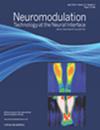通过自适应地逐步增加高频(10kHz)双相刺激的强度来阻断Pudendal神经。
IF 3.2
3区 医学
Q2 CLINICAL NEUROLOGY
引用次数: 0
摘要
目的:本研究的目的是确定自适应地逐步增加高频(10kHz)双相刺激(HFBS)的强度是否可以在不产生大的初始反应的情况下产生神经传导阻滞。材料和方法:在麻醉猫的左阴部神经上植入三个袖带电极进行刺激或阻断。用阴部神经刺激引起的尿道压力升高来测量HFBS引起的阴部神经传导阻滞。然而,在阻断阴部神经传导之前,HFBS通过在长时间(33-301分钟;平均108±35分钟)内每10至60秒自适应地逐步增加强度,并多次小强度增加(0.005-0.1 mA),从而引起无反应或低振幅高频尿道压变化。两种不同方法阻断阴部神经传导所需的最小HFBS强度相似。结论:这项研究对于更好地理解HFBS诱导的神经阻滞的可能机制很重要,并为开发一种新的神经阻滞方法提供了可能性,用于临床应用,其中最初的大反应是一个令人担忧的问题。本文章由计算机程序翻译,如有差异,请以英文原文为准。
Pudendal Nerve Block by Adaptively Stepwise Increasing the Intensity of High-Frequency (10 kHz) Biphasic Stimulation
Objective
The purpose of this study is to determine whether adaptively stepwise increasing the intensity of a high-frequency (10 kHz) biphasic stimulation (HFBS) can produce nerve conduction block without generating a large initial response.
Materials and Methods
In anesthetized cats, three cuff electrodes were implanted on the left pudendal nerve for stimulation or block. The urethral pressure increase induced by pudendal nerve stimulation was used to measure the pudendal nerve block induced by HFBS.
Results
HFBS applied suddenly with a large step increase in intensity induced a large (86 ± 16 cmH2O) urethral pressure increase before it blocked pudendal nerve conduction. However, HFBS applied by adaptively stepwise increasing the intensity every 10 to 60 seconds over a long period (33–301 minutes; average 108 ± 35 minutes) with many small intensity increases (0.005–0.1 mA) induced no response or low-amplitude high-frequency urethral pressure changes before it blocked pudendal nerve conduction. The minimal HFBS intensities required by the two different methods to block pudendal nerve conduction are similar.
Conclusion
This study is important for better understanding the possible mechanisms underlying the HFBS-induced nerve block and provides the possibility of developing a new nerve block method for clinical applications in which an initial large response is a concern.
求助全文
通过发布文献求助,成功后即可免费获取论文全文。
去求助
来源期刊

Neuromodulation
医学-临床神经学
CiteScore
6.40
自引率
3.60%
发文量
978
审稿时长
54 days
期刊介绍:
Neuromodulation: Technology at the Neural Interface is the preeminent journal in the area of neuromodulation, providing our readership with the state of the art clinical, translational, and basic science research in the field. For clinicians, engineers, scientists and members of the biotechnology industry alike, Neuromodulation provides timely and rigorously peer-reviewed articles on the technology, science, and clinical application of devices that interface with the nervous system to treat disease and improve function.
 求助内容:
求助内容: 应助结果提醒方式:
应助结果提醒方式:


